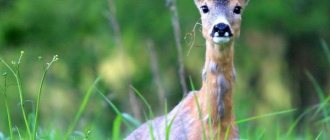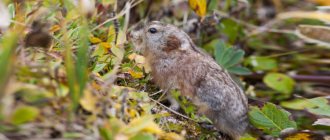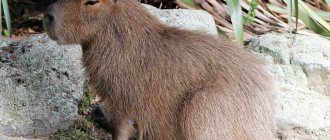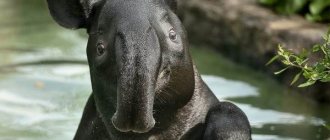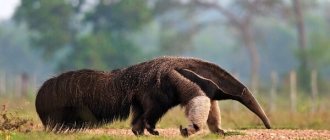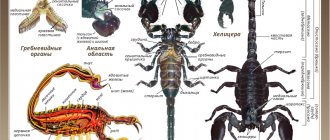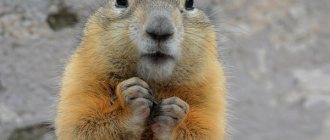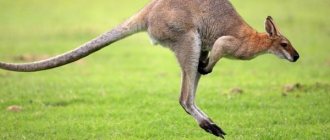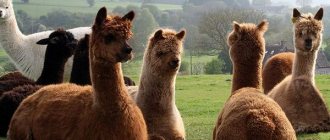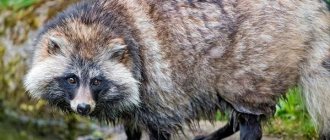Raccoons are a genus of mammalian predators. For a long time, there was a debate in the scientific community about the belonging of the genus to canines, felines or mustelids. In the 18th century, the raccoon family was introduced into the biological classification, which currently includes four species of raccoons, the Central American and North American raccoons, several species of olingo and nosuha.
Raccoons are considered valuable fur-bearing animals. Raccoon fur is one of the most wear-resistant, it repels moisture well, retains heat, and is lightweight and beautiful.
Description, structure, characteristics
The name "raccoon" comes to us from the Indian word "Arakun", which translates as "scratching with one's hands."
Raccoons are carnivorous mammals belonging to the raccoon family, which includes four species of these animals (we will describe each species in more detail below). Also close relatives of raccoons are raccoon dogs (they are often confused with raccoons), nosuhi, kakimitsli and kinkajou. And the raccoon’s distant relatives even include dogs and pandas.
The most common among raccoons is the raccoon, which is also called the “gargle bear” or “washing bear.”
The body length of raccoons is usually 45-60 cm; the average weight of a raccoon, depending on the species, can vary from 2-5 to 8-15 kg. Moreover, males are often larger than females. The body structure of raccoons is a bit like
a fox or a dog. But the paws of a raccoon are an important distinguishing feature of these animals; they have very elongated pads, somewhat reminiscent of human palms. Thanks to the similar structure of their paws, all raccoons have excellent grasping abilities.
Raccoons climb trees with ease and can manipulate various small objects.
A raccoon's tail is long and usually bushy. A raccoon's fur depends on its species; for example, the raccoon's fur is short, while the raccoon's, Cosemelle and Guadalupe raccoons' fur is, on the contrary, longer and fluffier. As for color, all raccoons are grayish-brown in color, and their tail is painted with transverse black and white stripes.
The raccoon's head is very wide, has a short and sharp muzzle, and small and rounded ears.
Interesting fact: all raccoons not only climb trees with ease, but also swim well, and can swim even in cold water, which is facilitated by the special composition of their fur, consisting of 90% thick undercoat, as if specially adapted by nature to protect against cold water.
Price
An exotic animal can be purchased at a special nursery. The price of a striped raccoon depends on a number of factors: age, color, physical characteristics, species. The cost ranges from 15,000 to 30,000 rubles. Buying from private sellers may result in the purchase of an extremely aggressive and sick animal.
The striped raccoon in the photo always looks like the cutest creature. Buying a pet often disappoints inexperienced owners. Knowledge of the peculiarities of keeping, the ability to raise predatory pets, responsibility for the small life of a natural inhabitant will create harmony in the relationship between an interesting animal and a person.
Habitats
Where do raccoons live? Raccoons are native to North and South America and can be found in forests from Canada to Argentina. With the discovery of America by Europeans, raccoons came to Eurasia and one of their species, the striped raccoon, was able to take root quite well in our latitudes. In particular, populations of the striped raccoon have been created in many European countries and also in the Caucasus.
As for our country, Ukraine, in the hometown of the author of the article - Lviv, there is a whole raccoon farm - “
Raccoon House”, that is, you can come to visit the raccoons, play with them; such an event will definitely be unforgettable for children. To learn more about the “Raccoon House” in Lviv, follow the link.
Raccoon's house.
Character and lifestyle
Raccoons have a friendly character, they are peaceful, active and inquisitive. However, despite their peacefulness, they are not cowardly, therefore, in case of danger, they are able to bravely defend themselves, bite and scratch. They can also rumble threateningly, trying to scare a potential enemy. In particularly dangerous situations, raccoons may flee or resort to a cunning trick - pretending to be dead.
Despite their friendliness and sociability, in natural conditions raccoons prefer to lead a solitary lifestyle, coming together only for mating and during hibernation. And yes, raccoons, like
Bears go into hibernation in winter, and the biological mechanisms of hibernation in raccoons are similar to those of bears; hibernation itself in raccoons lasts depending on the duration of the cold period. Canadian raccoons sleep the longest, in which hibernation can last up to 5 months, but raccoons living in the warm tropics of Central America do not hibernate at all, due to the lack of winter in their habitats.
Sleeping raccoon.
Raccoons are crepuscular animals, which means they are most active in the evening and at night, preferring to sleep in their cozy den during the day. But when evening comes, they go out in search of food. Although, if necessary, these animals can change their established daily routine.
Raccoon diet
The main natural habitats of raccoons are forested areas bordering various bodies of water or marshy areas. As a rule, forests have a sufficient number of hollow, old trees where a raccoon can rest during the daytime. This nocturnal predator has excellent night vision, which allows the animal to easily navigate in space and find food for itself. Moreover, the raccoon has sensitive vibrissae that grow on almost the entire surface of the body.
The raccoon is an omnivore, but its diet largely depends on its habitat. Since raccoons hibernate during the winter, when spring comes they need nutritious, high-calorie food. Immediately after hibernation, which occurs in February-March, the breeding season of raccoons begins. This process requires a lot of strength and energy, so their diet consists of high-quality protein foods, which can only be obtained from food items of animal origin.
Important point! Some anthropogenic factors that have been critical in nature relative to the overall abundance of various animal species have not had such a significant impact on raccoon populations. Raccoons have quite easily adapted to the extreme conditions of living next to humans and are accustomed to getting food for themselves in landfills or trash cans.
Raccoons hunt large insects, as well as small rodents and frogs. Raccoons deftly climb trees, so their prey can be bird eggs and chicks. Raccoons often hunt snakes and lizards, as well as various living creatures that live in bodies of water, such as crabs, crayfish, fish, etc. At the end of summer, when the fruits of various trees and shrubs ripen in the forests, they switch to feeding on nuts, acorns, berries, etc. For some countries, raccoons pose a serious threat because they raid plantations of various crops.
Enemies in nature
In turn, raccoons themselves can become prey for other larger predators: bears,
wolves, lynxes, coyotes, wolverines and cougars. In an attempt to escape from their enemies, raccoons often resort to trickery - pretending to be dead, but when this trick does not work and it is not possible to escape, they desperately resist, fighting with all their might for their lives. However, unfortunately, this is not always possible.
Also, to a certain extent, humans are the enemy of raccoons; American Indians sometimes killed these animals for their fur. Later, white colonists also began to practice hunting raccoons. Fortunately, the active reproduction of these animals has not put their population at risk.
Types, photos and names
As we wrote above, there are 4 types of raccoons in nature, and below we will describe them in more detail:
Raccoon gargle
This raccoon got its unusual name due to its habit of rinsing caught prey in water. Thus, the clean raccoon cleans it of sand. It is also the most common among raccoons, found throughout North and Central America, and more recently in Europe. Everything we wrote above concerns primarily raccoons.
Racoon crayfish (aguara)
A distinctive feature of this raccoon is a characteristic pattern around the eyes, somewhat reminiscent of a bandit mask. This raccoon has shorter fur and a more streamlined body. It got its name from its gastronomic love for crayfish. Lives in the jungles of Central and South America.
Cozumel raccoon
This species of raccoon is very rare, as it lives in a limited area, namely on the small island of Cozumel in the Caribbean Sea. It also differs from its other relatives in its brownish-grayish fur and the presence of a yellow tint on the tail.
Guadalupe raccoon
This species of raccoon is currently critically endangered and is listed as
Red Book. It lives in the humid areas of Guadeloupe, preferring to settle in marshy areas, as well as near reservoirs, rivers and lakes. Its appearance is similar to a striped raccoon.
Common subspecies of striped raccoon
— Advertising —
To date, 22 subspecies of striped raccoon are known. Among the most common and distinguishable are two:
Tresmarias raccoon (Procyon lotor insularis)
A subspecies of the striped raccoon, which is common in the Maria Islands and in western Mexico (Nayarit state).
Larger in size: body length from 85 to 90 cm (including tail). The fur is short and faded. The belly is brown with lighter undercoat. The animal is distinguished by an angular-shaped skull.
By the end of the 20th century, Tresmaria raccoons were in danger of extinction, with only about 250 adult animals remaining in the wild. At that time they were actively hunted by local residents, and no measures were taken to protect the subspecies. Today the population still remains small.
Bahamian raccoon (Procyon lotor maynardi)
This subspecies is endemic to the Bahamas (Caribbean Sea).
Outwardly, it is very similar to the mainland striped raccoon, but smaller in size. The animal is 41-50 cm long, the tail is 20-30 cm long. Males are slightly larger in size than females. The fur is gray with an ocher tint in the neck and chest area. There are individuals painted in intense black color. The tail is decorated with colored rings (from 5 to 10).
At the end of the 20th century, this subspecies was classified as endangered, at which time the population included about 2,500 individuals. Despite this, no measures have been taken to preserve the Bahamian raccoon, and as humans develop wild lands, its population continues to decline steadily.
Reproduction
Raccoons breed strictly once a year, during their mating season, which occurs either at the end of winter or at the beginning of summer (depending on the raccoon’s habitat, the further south it lives, the faster its mating season begins, for raccoons living in our temperate latitudes, the mating season is in early summer).
These animals have no special mating rituals, everything is extremely simple - the male finds the female by smell and mates with her. The pregnancy of a female raccoon lasts 2 months; birth occurs in some secluded place, usually a hollow tree or an abandoned hole of another animal.
From 3 to 8 small raccoons are born at a time. Baby raccoons, like kittens, are born blind and helpless, and at first they are under the full care of their mother, who feeds them with her breast milk. But after a month of their life, they begin to grow rapidly, by 4-5 months they are already able to obtain food on their own, and by the first year, raccoons reach sexual maturity and become adults.
Keeping at home
Raccoons make excellent pets due to their friendly nature. Just don’t get a raccoon if you live in a cramped apartment, since these animals need space, and they won’t be free-range like cats or dogs either.
It is very advisable to allocate a whole separate room for the raccoon; it will also be its enclosure, in which the animal will feel free. Since raccoons are very smart animals, you can have fun and play with them, but you should also be careful, because if the raccoon thinks that it is in danger, it can bite and scratch. Raccoons are especially aggressive during their mating season. Also, during the mating season, a male raccoon can mark his territory, which will be fraught with a very unpleasant odor. But in general, a raccoon can be trained to go to the litter box, almost like a cat or dog.
It is also worth considering that raccoons can be very mischievous, even hooligan animals; while living in a house, they can do all kinds of mischief, for example, break all the dishes in the kitchen, throw over an expensive TV, and so on. To avoid this, they should not be released from their enclosure room (at least without supervision), having first removed all valuable items from there.
And raccoons are crepuscular animals, which means that if you have such a pet in the house, you will need to adapt to its natural rhythm; the raccoon will most likely sleep during the day, but get rowdy in the evening and at night. You will also need to feed him in the evening and at night, in general, if you are a “night owl” according to your biorhythm, then with a raccoon it will be easier for you than for people who are “larks”.
Raccoon as a pet
Cute and smart raccoons leave no one indifferent. It is not surprising that recently more and more people keep them as pets. Before you decide to purchase such a pet, you should take into account all the difficulties that are usually associated with keeping a raccoon.
Raccoons give the impression of cute and funny little animals, but do not forget that by their nature they are a wild predator. If you do not accustom it to yourself before puberty, the matured animal will definitely show its character: raccoons become aggressive not only towards strangers, but also towards their owners. The animal requires a lot of attention. You should not take a raccoon into your home if you are not willing to spend 3-4 hours a day with it.
Raccoons are curious and energetic animals. While awake, they are constantly on the move, exploring everything around them. An animal left unattended can ruin things and food, unscrew a water tap or chew through wires. When keeping the animal indoors, it is recommended to lock the animal at night and while away from home in an enclosure.
The enclosure must be spacious enough for the pet to move freely. Inside you need to place a tray, bowls with water and food, a resting house and a large bowl or bathtub with water in which the raccoon will wash the food. With proper and regular care, the animal does not have an unpleasant odor.
The diet of a raccoon in captivity can consist of minced meat and fish, eggs, cereals, fruits and vegetables.
CHINCHILLA
What to feed
What to feed your pet raccoon? A partially omnivorous raccoon can be fed with the same things it has in its natural environment: these are various berries, fruits, and nuts. In addition, raccoons can be fed with specialized food for cats and dogs, but only premium food. You can give meat and fish, both raw and boiled, the main thing is not too fatty. Chicken, beef, turkey, veal and rabbit are excellent meats for raccoons. Raccoons eat excellent fruits: apples, pears, grapes, bananas, peaches, plums. Vegetables that will be useful to raccoons include: carrots, fresh peas, asparagus, and zucchini.
Maintenance and care of a raccoon
You can become its owner only after the cub becomes an independent animal. How long a raccoon lives with its mother is quite easy to determine. The period is about six months. But there are times when the baby stays with his mother for up to nine months.
Author: David Naumov
Caring for an animal is not difficult, but it must be done constantly and in compliance with the conditions.
Residents of a private house can simply shelter a raccoon with a spacious garden plot. Both a house made of boards and an aviary are suitable for him. The animal is so unpretentious that it can live in an empty room, in an attic or attic. What is needed to keep such a pet:
- A container filled with water. You can stay in it in hot weather and wash objects you find;
- An overnight stay at a short distance from the ground will be much more familiar for your pet. It’s a good idea to fill this area with sawdust and pieces of fabric;
- Provide a place to climb.
If the raccoon is going to live in an apartment, it is better to give it a separate room or enclosure to stay in when the owner is absent. Close windows and ventilation with screens and check the locks, as the latches will not be able to stop a curious animal.
Author: Vasilina Selezneva
What does a raccoon eat?
Domestic raccoon food products:
- Frogs, lizards and small rodents;
- Eggs, fish;
- Fruits, grass, nuts, mushrooms and berries;
- They can eat food for cats and dogs.
You should not feed your pet canned food or sweets, as this will not only become a source of unpleasant odor from your pet, but will also have a detrimental effect on its body.
Interesting Facts
Video
And finally, an interesting documentary about raccoons.
Author: Pavel Chaika, editor-in-chief of Poznavaika magazine
When writing the article, I tried to make it as interesting, useful and high-quality as possible. I would be grateful for any feedback and constructive criticism in the form of comments on the article. You can also write your wish/question/suggestion to my email [email protected] or Facebook, with respect, the author.
Author page
This article is available in English -
Raccoon.

